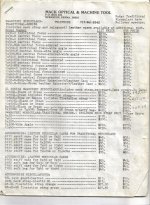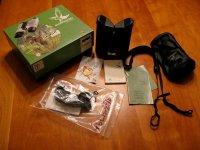ksbird it's all a matter of tolerances.
And the fact is you can tweak a phase compensating layer just the same way as you design any multilayer, for a anti-reflection coating or a dielectric mirror coating, to work well enough across the visible light spectrum given the other limitations in a bin. You don't as you seem to imply in your first reply have only 4 parameters to use: you have two parameters per layer (refractive index and thickness) and N (say 64) layers. Solve the Fresnel equations for that stack (assuming you can manufacture arbitrary stacks) and you can minimize the phase differences to an arbitrary level. As you can minimize the reflection in an AR coating or maximize the reflection in a dielectric mirror.
Human acuity is only about 1 minute of arc with some extra processing features in the brain that can exceed that for very special cases (verier positioning and the like). Bins even those roofs that don't have phase correction regularly exceed this. They may have other problems (scatter, diffraction spikes, contrast issues) but in a well designed bin thaty actually come quite close.
Sure you a roof can't better a porro but it can be indistinguishable for the human eye.
So to address thee other questions you raised in an early: why does none make top end porros any more?
Roofs do have real advantages which you ignore in your reply. It's not just optical quality. It's ergonomics and other features that count too.
- Roofs are more compact than porros.
- Roofs are lighter than porros.
- Roofs are easier to make waterproof and fogproof (and stay that way for life) than porros because you can seal the barrels. Porros could use internal focusing to do this (and some do) but they all seem to have a narrow FOV (perhaps because an internal focusing mechanism are more limited in a porro design?).
- Roofs were more rugged than porros. Though this was due to gluing prisms in place and the prisms sub-assemblies being supported on all sides by the barrel something you can't do in porro as the light path is in the way. Modern Chinese porros (eg. the Leupold Yosemite) show that you can use these same techniques to make a porro very nearly as rugged as a roof.
So why do the Euro 3 not make top end porros? Money and the market.
Which would you choose? 20% of $500 or 20% of $2000? Bin makers know that it's more expensive to make roofs but that they can sell them for more. So for a given margin they make more revenue. They also know that they can make more "new" innovations so as to compete with other makers. For porros any moderately competent optical company can do it. And there are good optical companies in places like China where the costs are much less than Europe. But they still have to deal with the consumers. Will they buy them?
But why did porros go "out of style"? Social trends like the expert birders in the 1970s using the expensive roof prisms bins because they were waterproof and rugged (real positive effects as the porros weren't). Of course other birders notice that the alpha birders are using roofs and want to be like them. And then they realize that they can be more compact and lighter too. Remember the good old days of > 32oz 8x40s? People haven't forgotten especially those that voted with their necks too.
There were also manufacturing trends too. A lot of the old porro makers were older companies stuck with older ways of doing things (e.g. making porros easier to recollimate rather than making it more difficult for them to get out of collimation). They came to be seen as old fashioned. Leica (then Leitz) got out of the porro design business in 1960 to focus on roofs. They still sold porros but there wasn't a new porro design after 1962. Zeiss followed a little later. Compare that to, say , Swift, who didn't make a move to roofs until the 1990s.
Birders don't just choose bins for their optical qualities. That would be a typical "geek" bias. They have many different reasons for choosing a particular bin: feel, weight, shape, FOV, AFOV, grip, balance, perceived benefits (ruggedness), brand, etc. These features have nothing to do with the "quality of the view". We've seen a parallel evolution in the automobile too: it's not about 0-60 time or horsepower for most people. It's cupholders and comfy seats.
There is also a behavioral economics effect called "price anchoring" by which people (both buyers and sellers) fix a lower bound price price they are willing to accept. The price anchors for porros and roofs have split in most peoples minds. People are happily anchored on an alpha bin must cost > $1000. So they'll pay that.
e.g.
http://sloanreview.mit.edu/wsj/insight/interview/2008/09/22/
So roofs can get away with charging more because, after all "that's what you have to spend for quality": the same sort of argument applied to preferring a Rolex mechanical watch with worse timekeeping capability than the $20 Casio.
One interesting problem for the upper-mid and (perhaps) the alpha roofs is coming from Chinese optics manufacturers moving upmarket. So we have no-name brands like Promaster and Hawke (sorry, Hawke!) putting out very, very good roof bins in the lower middle price range (currently $400 to $500). These bins are one third to a quarter the price of the Alpha bins if not quite at the same quality point. But they're close enought for most people. If people buy on "good enough" quality and not brand name what is going to happen to the upper end of the market? Actually I think the Euro 3 (or should that be "The Axis" 4 if we include Nikon) have brand name recognition to maintain their place. But I think the others in the market will struggle.
So you might think after all that I'm a rabid roofie fan? Not really.
I actually agree with your premise. I just think your making an invalid argument for it. As I've pointed out in my own bins reviews inexpensive modern porros are beatings roofs costing two to three times the price but still people buy roofs (even people like me!).
So what can be done?
You can make porros that equal the top end roofs for much less. You could apply modern techniques to making porros that would result in lighter (use GRP not metal), more rugged (glue the prisms in place), with internal focusers (can you get a wide FOV?), with state of the art multilayer AR coatings plus hydro and lipophobic coatings. Pay attention to enclosure design (we have the CAD technology and injection modling to do that now). They might even deal with stray light better than most roofs (roof biggest weakness, IMHO, excepting the Alpha roofs were they actually care about that during the design).
The problem is will people buy these hypothetical top end porros at middle range prices? I suspect that unless you are an "optics geek" (if you are reading this then you are one) people don't buy "big clunky bins" but prefer the "cuter, less clunky ones".






